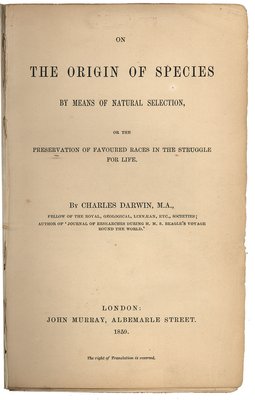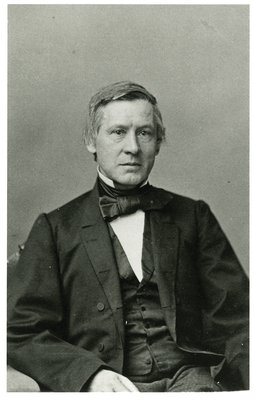
by David B. Williams Thursday, January 5, 2012

Ben Tillman, University of Sydney Library

Asa Gray was one of Charles Darwin's most vocal proponents in the United States in the late 19th century. Library of the Gray Herbarium, Harvard University
About a decade ago, I was fortunate enough to hold in my hands a first edition of Charles Darwin’s “On the Origin of Species.” The green cover was cracked and frayed. The cardboard backing protruded through the torn corners. I put the book down and stared at it in awe. The owner of this book was Asa Gray, one of America’s greatest botanists, an important early American supporter of natural selection, and a friend of Darwin’s.
Until I touched that historic edition, I had never had a desire to read “Origin of Species.” I understood the basics of the theory of evolution, so why read a Victorian-aged book bound to be impenetrable and filled with unwieldy sentences? Consider the rarely used title: “On the Origin of Species By Means of Natural Selection, or the Preservation of Favoured Races in the Struggle for Life.” How could this book be interesting?
I first heard about this unique copy of “Origin” while researching unusual materials owned by Harvard University’s natural history libraries. A librarian had told me that the university owned Asa Gray’s personal copy of the book. I wondered if Gray had made any notes in his book, so I asked if I could see it. The librarian said yes, and I returned to the red brick building two days later.
Inside the library, I handed over my book bag, filled out the required white form to request the book, and grabbed a Tootsie Roll from the ever-present jar of candy by the front door. (This candy jar almost led to a catastrophe. On another occasion, I had asked to see the letter that Darwin wrote to Gray on Sept. 5, 1857. In this letter, Darwin told Gray about his theories for the first time; it was later used as evidence for Darwin having his ideas on natural selection before Alfred Russell Wallace. Before the librarian handed me the letter, I had popped a piece of hard candy in my mouth. As I leaned over the letter, awestruck, I realized that if I opened my mouth and unwittingly dripped saliva on the paper, the librarians would justifiably have the right to shoot me. So I pushed the letter away, swallowed the candy and lived another day.)
Gray’s copy of “Origin” came in a gray, acid-free box. The spine, in simple black lettering, read “Origin of Species Darwin.” Before handing the book over to me, the librarian cautioned me to be careful as the book was not in good shape.
I carried the book over to one of the two reading tables, pulled out a chair, sat down and dried my sweaty palms on my pants legs. I was already nervous, and the librarian’s admonition only further exacerbated my nerves. Beyond the cracks and dog-eared corners, the binding and the cover had separated to the point that only the brownish endsheets held the book together. Gray either was careless with his books or had read and reread this one.
I pulled up my sleeves and opened one of only 1,250 copies of the first edition of “Origin of Species.” One of the apocryphal stories about “Origin” is that it sold out the first day it went on sale: This isn’t exactly true. On Nov. 22, 1859, publisher John Murray made 1,192 copies available to booksellers (the rest were review or presentation copies). The sellers ordered 1,500, but as modern authors know, getting a book to booksellers is different from getting people to buy it. The book took longer to get out of stores.
Surprisingly, neither Darwin nor Murray had high hopes for “Origin.” Just one month before publication, Darwin wrote to Murray: “I heartily hope that my Book may be sufficiently successful that you may not repent of having undertaken it.” Little did he know.
Turning past the dark brown endpaper of Gray’s book, I found where the publisher had written “From the Author” in ink now faded to golden brown. Gray had penciled in his name above it. Skipping over the epic title page, I discovered that writing his name was only the first of Gray’s many additions.
He peppered the margins with “Yes,” “Well put,” and numerous exclamation points. But he also read it like an editor, writing “too much personification” and “overdone, too fanciful,” adding commas and rearranging sentences. Despite his editorial comments, Gray clearly supported natural selection and became Darwin’s chief supporter in the United States.
Gray’s copy of “Origin” also contained two pages of Darwin’s handwritten notes pasted into the back. Darwin’s comments addressed several errors in the first edition, as well as clarified information on domesticated dogs and slave ants. Darwin sent these notes in January 1860, so that Gray could facilitate the publication of an American edition of “Origin.” Gray was instrumental in this endeavor because the United States did not recognize foreign copyright in 1859; therefore, anyone with a copy could publish a new edition of “Origin.” Gray helped arrange for a single American edition to be published in New York by Appelton. By May 1860, Appelton had sold 1,750 copies of the book.
Only a week after looking through Asa Gray’s copy, I had the opportunity to examine another first edition of “Origin.” Louis Agassiz, one of America’s foremost opponents of the theory of evolution in the 1860s and Gray’s colleague at Harvard, owned this copy. “From the Author” adorned the frontispiece of his book too, and Agassiz also wrote in the margins. But the similarity with Gray’s “Origin” ended there. No cracks marred the green cover and the corners lacked dog ears, and Agassiz’s comments were far less supportive, ranging from “This is monstrous” to “The mistake of Darwin” to “A sentence likely to mislead!”
After skimming these two books, mostly looking at the owners’ comments, I felt obligated to purchase and read my own copy of “Origin of Species.” Darwin’s writing pleasantly surprised me. He occasionally baffled me with long, ponderous ramblings. But for the most part, I found the book to be compelling and thought provoking. Despite the fact that Darwin wrote the book from his country home in England, he referred to rhododendrons in the Himalayas, tyrant flycatchers in South America, slave-making ants in Sussex and glaciers in North America. He also discussed plants and animals as diverse as legumes and lemurs, parasites and pigeons, and beetles and bats.
My greatest surprise in reading this book was that Charles Darwin never used the phrase “survival of the fittest.” He came close, using phrases like “individuals having any advantage ... would have the best chance of surviving” or “the selected form having some advantage in the struggle for life over other forms.” The precise four-word aphorism, however, did not appear until the fifth edition, printed in 1869, a decade after the original publication. Furthermore, Darwin did not even coin the maxim — English philosopher Herbert Spencer first used “survival of the fittest” in 1862 in his “Principles of Biology Volume 1.”
After reading “Origin,” I decided to find out if I was alone in my prejudice against the book. Over several months, I asked scientists, science journalists and friends if they had read it. The responses ranged from “I once read a book with origin in the title. Does that count?” to “Of course, I even celebrate Darwin’s birthday.” This same friend said that he had self-consciously kept a copy of “Origin of Species” in his hip pocket during junior high school. He read it then and continues to reread it “for its constantly new insights and graceful language.”
Most of the people I asked could not claim such familiarity with “Origin.” They knew of the book, but they had read only passages or at most a chapter or two. Of the few who had finished the entire book, most had been required to read it for a class. I only found one or two people who had read it of their own accord. When I asked the acclaimed scientist and writer Stephen Jay Gould why he thought that so few people read “Origin,” he responded: “It’s a philistine nation. Who reads much of anything these days?”
Indeed, most of the people with whom I spoke are prolific readers and are familiar with natural history writing. But they, like me, still take Darwin for granted; his theory has been explained, updated and proven, so why read “Origin of Species”?
The reason is simple: We should read “Origin” to honor Darwin. Natural selection changed the way humanity thinks about itself and the world around us. Few natural scientists have had such an impact. One hundred and fifty years after this great book’s publication, we owe it to Darwin to read “Origin of Species” because it clearly presents one of the most important ideas ever proposed. Plus, it is actually a good read.
© 2008-2021. All rights reserved. Any copying, redistribution or retransmission of any of the contents of this service without the expressed written permission of the American Geosciences Institute is expressly prohibited. Click here for all copyright requests.